Bak Kwa (肉干, rou gan) is the Chinese version of pork jerky, made with thinly sliced or minced pork, seasoned with soy sauce and sugar, and grilled over charcoal with an open fire. Bak Kwa, pronounced in Hokkien, is my favorite snack, especially during Chinese New Year.
The idea of making bak kwa (Chinese pork jerky) leads me to an extensive search on the internet and books for the best recipe.
Living in an apartment also means I have to forgo grilling it on the barbecue pit.
Here is my surprisingly simple method to make bak kwa. it gets universal approval from all my testers for its tastes and is comparable to any famous brand in town.
If you want to try your hand at making bak kwa, this recipe will likely be the easiest and most delicious one.
I will unfold all the tricks and alternatives to suit your taste buds.
Let’s get into the details.
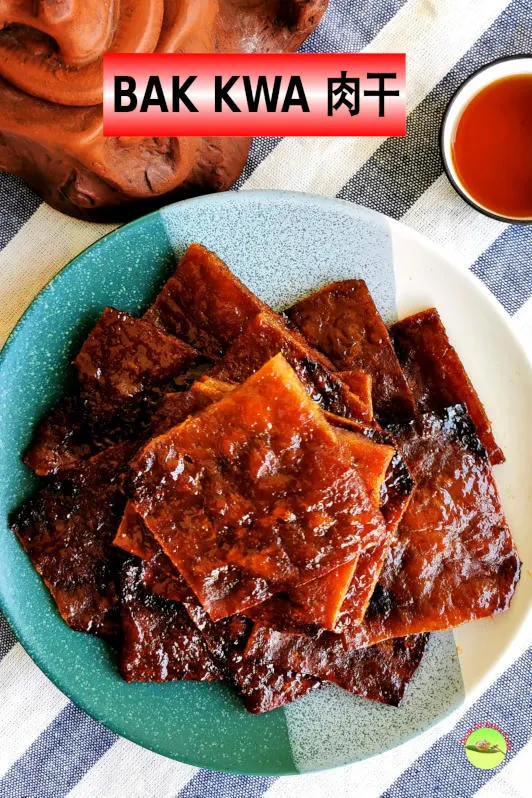
Note: This post may contain affiliate links. Please read my privacy policy for more info. I may receive commissions for purchases made through links in this post. As an Amazon Associate, I earn from qualifying purchases.
1. The best choice of meat for making bak kwa
The most popular meat for bak kwa is pork. You can substitute it with chicken meat to make chicken bak kwa. In this case, chicken thigh meat is better than breast meat because it is juicier.
The more elegant bak kwa is made with thinly sliced pork, which is pricier and regarded as of better grade. However, making it at home is difficult because you must slice the large pieces of meat thinly.
The more common bak kwa is made with ground pork. If you mince the pork yourself, I suggest using pork butt, which has a good amount of fat. Cut the pork into small pieces and grind it to a paste with the food processor.
Alternatively, you can save time using ground meat sold at the butcher. Make sure it has a fat content of 20 to 30 percent. Bak Kwa, made with lean meat alone, is dry and hard.
Note: Pork is almost exclusively used to make Bak Kwa, since many Chinese do not take beef. However, things have slowly changed, and Chinese beef jerky using the same preparation method has become popular. Chikan bak kwa is also getting popular as it has a universal appeal to all races.
2. The best seasoning for making bak kwa
The main seasonings for bak kwa are sugar and soy sauce. Sugar provides a dark caramelized color, complementing the flavor with soy sauce.
Regular sugar is good enough to make bak kwa, but adding some honey can improve the flavor. Some recipes also use maltose, a common ingredient in Chinese cooking. Reduce the amount of sugar accordingly to get the right level of sweetness. If you want to use sugar or maltose,
Two types of soy sauces can be used to make bak kwa. Dark soy sauce darkens the color to make it look more attractive. Light soy sauce improves the flavor and is a better choice for the pork jerky’s saltiness. Since I use fish sauce in my recipe, I have decided to omit the light soy sauce, but you add some if you like its taste.
Oyster sauce and fish sauce are also regularly found in bak kwa recipes. The familiar flavor is the result of the combination of these seasonings.
Other supporting ingredients are Shaoxing wine, Chinese five-spice powder, ground white pepper, and salt. The wine can be omitted if you are making the pork and alcohol-free variant.
Some recipes include red bean curds, red yeast rice, and artificial coloring to give it a reddish color. I do not use any of these items as my bak kwa looks attractive without these ingredients.
Note: The amount of seasonings in the following recipes is based on my preference. You can use it out of the box or adjust the amount to suit your taste.
3. Combine the ingredients and rest
The preparation of the meat jerky is straightforward. All you need is to mix the seasonings and the minced meat. Mix it very well with a pair of chopsticks, or use the traditional method by repeatedly lifting the meat paste and smashing it into the bowl. This step alters the meat’s texture, helps it absorb the liquid seasonings, and turns it into a gooey paste. I use this ‘smashing’ method to prepare my Chinese meatballs.
Let the meat paste rest in the refrigerator for an hour until the meat absorbs all the liquid seasonings.
4. Spread the meat paste onto a thin sheet
Once the meat paste is ready, spread it to form a thin layer on baking paper.
Here are the steps
- Cut a piece of baking paper slightly larger than nine inches (23 cm) square.
- Place 5 oz (150g) of the meat paste on the baking paper.
- Cover the meat paste with a piece of cling wrap or plastic wrap. (I prefer using plastic sheets, which can be washed and reusable).
- Place your hand on the plastic sheet to spread the meat paste.
- Roll out the meat paste evenly with the rolling pin and shape it into a nine inches square.
- Straighten the four sides with a dough cutter.
- Remove the plastic sheet, and transfer the meat paste with the baking paper to a baking tray.
Tips:
- Using your hand to feel the thickness is easier than depending on the rolling pin. Even thickness is essential because any thinner part will get burned quickly while baking (or grilling).
- An easy way to straighten the sides is using a dough cutter to push back the meat paste to the center
- 150g of meat paste is the ideal amount to roll out to a 9×9 inches square. This square will eventually be cut into four square pieces, producing size and thickness similar to those selling in the stores.
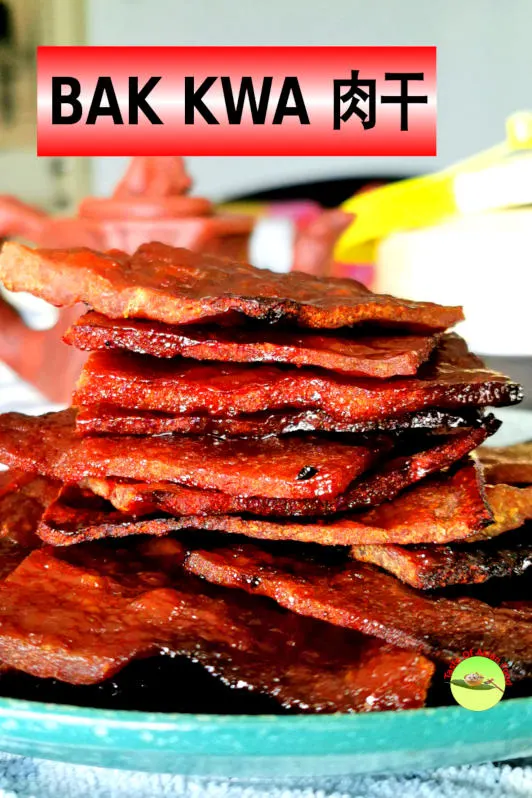
5. How to grill the bak kwa with the oven
Baking the bak kwa is a two-step process.
a) First grill: to form a sheet of cooked meat
- Preheat the top and bottom heating elements of the oven to 160°C/320°F.
- Place the tray of raw meat paste in the preheated oven on the middle rack to grill for 15 minutes.
- The color of the meat will darken slightly, and the size will shrink significantly. It will eventually turn into an elastic and pliable sheet of cooked meat.
- Transfer the cooked meat to the chopping board. (Caution: Hot! Please use a pair of tongs).
- Cut it into four smaller squares.
b) Second grill: grill it until reddish-brown with some charred marks
- Prepare the basting liquid by combining four portions of honey with one portion of water.
- Brush the honey liquid on both sides of each half-done bak kwa.
- Arrange it on a wire rack with small gaps in between.
- Adjust the temperature of the oven’s top and bottom heating elements to 230°C/ 445°F.
- Grill at the center rack. The duration varies depending on the distance of the bak kwa from the heating elements. In my case, it takes about six minutes to start sizzling.
- Once it sizzles, open the oven door and turn over the bak kwa. Do this every two to three minutes to ensure even grilling.
- Once the edges start to char, remove it immediately from the oven.
Note:
- Please note that not all the bak kwa will change color simultaneously, as it depends on the heating element’s position and the placement of each piece.
- I prefer grilling the bak kwa with both top and bottom heating elements. Some recipes suggest using only the top element to broil them. I tried this method and found that they can burn quickly. Since broiling only works if the meat is positioned on the top rack and close to the top element, it isn’t easy to get an even browning with slight charring on the edges.
- The result is very close to the charcoal grill bak kwa. The difference is nearly unnoticeable.
Options available after the first grilling
There are a few options to proceed with after the first grilling session.
- If you don’t have a barbecue pit, you can proceed immediately to the second grilling session with high heat, as in this recipe.
- If possible, grill the half-done bak kwa over a BBQ pit. The finished product will look the same as what I did in my oven, but you will get the signature smoke flavor like those purchased from the sellers. BBQ is the ideal method I wish for, but unfortunately, it is impossible with my kitchen’s limitations.
- If you want to make a large batch of these popular treats for the Chinese New Year in advance, wrap each piece (after first grilling) separately with wax paper or a thin plastic sheet and keep them in the freezer. When you want to consume them, grill them the second time, as in this recipe, or finish them over the barbecue pit.
Many street vendors who become bak kwa sellers in Malaysia during the Chinese New Year season do not make them from scratch. They get the half-done stock from the wholesale supplier and BBQ them later. That is why the taste of various street vendors is nearly identical.
Storage
Bak Kwa can be kept in the refrigerator for up to 1-2 weeks. The most common method is to wrap the bak kwa with a plastic sheet and another piece of parchment paper. It can be kept at room temperature in an airtight container for more than a week.
You can store it in the freezer for an extended period of up to a few months. When you want to consume it, remove it from the freezer, wait until it returns to room temperature, and then microwave it until it gets warm.
Other related recipes to Bak Kwa (and Chinese New Year)
If you like this Bak Kwa recipe, you may also want to look at the related recipes, which are all popular dishes during Chinese New Year.
Buddha’s Delight is the ultimate vegetarian dish for the Chinese New Year. It is almost universal that each family will cook this dish or its variants on the first day of the New Year.
Braised chicken with mushrooms will be the choice of meat for this festive season. It can be prepared in advance for a day or two to ease the busy cooking schedule on a festive day.
Pineapple tart is a must-have snack during Chinese New Year because pineapple is the homonym of the phrase ‘prosperity is arriving.’ Therefore, it is most fitting for Chinese New Year as it signifies prosperity.
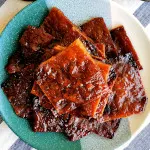
Bak Kwa
Bak kwa 肉干 is the Chinese version of pork jerky, made by thinly sliced or minced pork, seasoned with soy sauce and sugar, and grilled over charcoal with open fire.
Ingredients
- 450g (1 pound) of pork shoulder loin, minced
- 105g (3.8 oz) of sugar
- 1.5 tsp of dark soy sauce
- 2 tbsp of oyster sauce
- 2 tsp of fish sauce
- 1 tbsp of Shaoxing wine
- 1 tbsp of honey
- 1/4 tsp of 5 spice powder
- 1/2 tsp of white pepper
- 1/2 tsp of salt
- Basting liquid (mix 1 tbsp of honey w/ 1 tsp of water)
Instructions
- Mix all the ingredients, except the honey water. Mix until the ground meat absorbs all the liquid seasonings and become a gooey paste.
- Store in the refrigerator for one hour or longer.
- Place 150g of the meat paste on a piece of baking paper. Place a plastic sheet on top and flatten the meat paste with your hand.
- Roll out the meat paste with a rolling pin to form a nine inches square. Remove the plastic sheet.
- Preheat the oven to 160°C/320°F, top and bottom heating elements.
- Place the tray of raw meat at the middle rack, bake for 15 minutes.
- Remove and cut it into four smaller squares.
- Apply the basting liquid on both sides of each half-done bak kwa.
- Arrange the bak kwa on a wire rack.
- Bake at 230°/ 445°F, top and bottom heating elements.
- Once it starts to sizzle, turn over the bak kwa every two to three minutes to ensure even grilling.
- Once the edges start to char, remove it immediately from the oven.
Recommended Products
As an Amazon Associate and member of other affiliate programs, I earn from qualifying purchases.
-
 Rolling Pin & Silicon Pastry Mat,Silicone Large Pastry Mat With 19.6" x 15.7",Dough Roller Sleek and Sturdy 11.8" Perfect Match
Rolling Pin & Silicon Pastry Mat,Silicone Large Pastry Mat With 19.6" x 15.7",Dough Roller Sleek and Sturdy 11.8" Perfect Match -
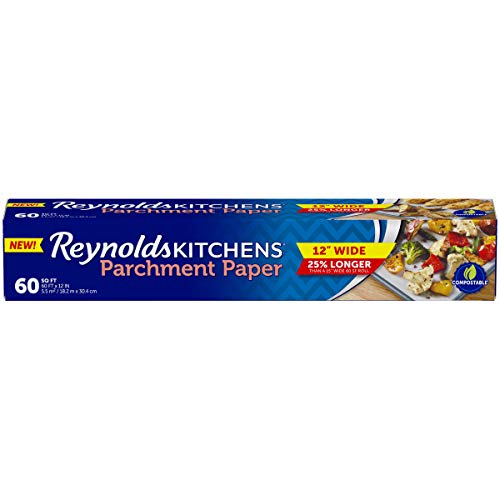 Reynolds Kitchens Parchment Paper Roll, 60 Square Feet
Reynolds Kitchens Parchment Paper Roll, 60 Square Feet -
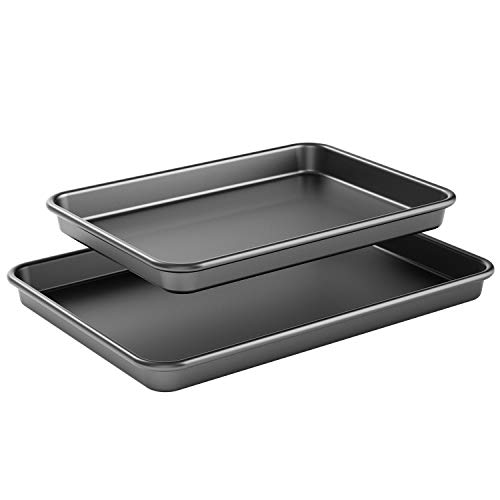 Super Thick 0.7mm Nonstick Cookie Sheet Pan, Metal Baking Tray, 2 Pack Baking Sheet Pans, Large and Medium Cookie Pan Set
Super Thick 0.7mm Nonstick Cookie Sheet Pan, Metal Baking Tray, 2 Pack Baking Sheet Pans, Large and Medium Cookie Pan Set -
 EXTRA LARGE Organic Bamboo Cutting Board with Juice Groove - Kitchen Chopping Board for Meat (Butcher Block) Cheese and Vegetables | Anti Microbial Heavy Duty Serving Tray w/Handles - 18 x 12"
EXTRA LARGE Organic Bamboo Cutting Board with Juice Groove - Kitchen Chopping Board for Meat (Butcher Block) Cheese and Vegetables | Anti Microbial Heavy Duty Serving Tray w/Handles - 18 x 12"
Nutrition Information:
Yield: 16 Serving Size: 1Amount Per Serving: Calories: 114Total Fat: 6gSaturated Fat: 2gTrans Fat: 0gUnsaturated Fat: 3gCholesterol: 25mgSodium: 240mgCarbohydrates: 8gFiber: 0gSugar: 8gProtein: 7g
This data was provided and calculated by Nutritionix on 1/4/2021

Chinese New Year recipes - 10 auspicious food that brings you prosperity
Thursday 9th of January 2025
[…] Click here to get the Bak Kwa recipe […]
Ng Ai Lin
Sunday 31st of January 2021
Mr Kwan, I made pork bak kwa today and the result is so good. Thank you.
KP Kwan
Monday 1st of February 2021
Glad to know that it works and you like it :)
Jennifer Quah
Sunday 31st of January 2021
This works so well to replicate bak kwa from Malaysia! Just made my first batch and it's passed the taste test with flying colours, thank you for sharing the recipe, KP. I need to experiment a bit more with the heat levels in my oven and maybe try it with the Shaoxing wine (I didn't have any this time) but otherwise it was really easy to follow your instructions and so useful to have tips alongside. Am so pleased with the results, (my husband says you're a genius btw) thanks once again for sharing :)
KP Kwan
Sunday 31st of January 2021
Hi Jennifer, Thanks for your kind words, and really happy that it is useful to you. Wishing you an early Chinese New Year. KP Kwan
Christina Chisholm
Tuesday 19th of January 2021
Thank you. Will try your version.
Christina Chisholm
Tuesday 19th of January 2021
Hi,
Which part of the pork should I buy if I want thinly sliced? Does it need to have some fats?
Thank you.
KP Kwan
Tuesday 19th of January 2021
I never tried to make thinly sliced pork bak kwa (切片肉干) at home, so I really cannot give you a suggestion. My version is using minced pork, so I use pork butt or shoulder loin.